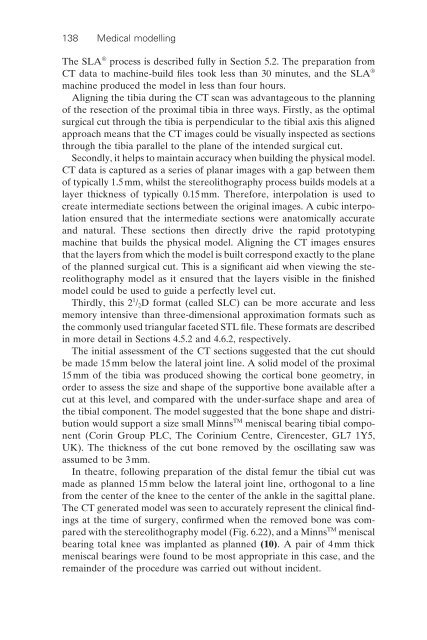R_Bibb_Medical_Modelling_The_Application_of_Adv.pdf
R_Bibb_Medical_Modelling_The_Application_of_Adv.pdf
R_Bibb_Medical_Modelling_The_Application_of_Adv.pdf
You also want an ePaper? Increase the reach of your titles
YUMPU automatically turns print PDFs into web optimized ePapers that Google loves.
138 <strong>Medical</strong> modelling<br />
<strong>The</strong> SLA ® process is described fully in Section 5.2. <strong>The</strong> preparation from<br />
CT data to machine-build fi les took less than 30 minutes, and the SLA ®<br />
machine produced the model in less than four hours.<br />
Aligning the tibia during the CT scan was advantageous to the planning<br />
<strong>of</strong> the resection <strong>of</strong> the proximal tibia in three ways. Firstly, as the optimal<br />
surgical cut through the tibia is perpendicular to the tibial axis this aligned<br />
approach means that the CT images could be visually inspected as sections<br />
through the tibia parallel to the plane <strong>of</strong> the intended surgical cut.<br />
Secondly, it helps to maintain accuracy when building the physical model.<br />
CT data is captured as a series <strong>of</strong> planar images with a gap between them<br />
<strong>of</strong> typically 1.5 mm, whilst the stereolithography process builds models at a<br />
layer thickness <strong>of</strong> typically 0.15 mm. <strong>The</strong>refore, interpolation is used to<br />
create intermediate sections between the original images. A cubic interpolation<br />
ensured that the intermediate sections were anatomically accurate<br />
and natural. <strong>The</strong>se sections then directly drive the rapid prototyping<br />
machine that builds the physical model. Aligning the CT images ensures<br />
that the layers from which the model is built correspond exactly to the plane<br />
<strong>of</strong> the planned surgical cut. This is a signifi cant aid when viewing the stereolithography<br />
model as it ensured that the layers visible in the fi nished<br />
model could be used to guide a perfectly level cut.<br />
Thirdly, this 2 1 / 2D format (called SLC) can be more accurate and less<br />
memory intensive than three-dimensional approximation formats such as<br />
the commonly used triangular faceted STL fi le. <strong>The</strong>se formats are described<br />
in more detail in Sections 4.5.2 and 4.6.2, respectively.<br />
<strong>The</strong> initial assessment <strong>of</strong> the CT sections suggested that the cut should<br />
be made 15 mm below the lateral joint line. A solid model <strong>of</strong> the proximal<br />
15 mm <strong>of</strong> the tibia was produced showing the cortical bone geometry, in<br />
order to assess the size and shape <strong>of</strong> the supportive bone available after a<br />
cut at this level, and compared with the under-surface shape and area <strong>of</strong><br />
the tibial component. <strong>The</strong> model suggested that the bone shape and distribution<br />
would support a size small Minns TM meniscal bearing tibial component<br />
(Corin Group PLC, <strong>The</strong> Corinium Centre, Cirencester, GL7 1Y5,<br />
UK). <strong>The</strong> thickness <strong>of</strong> the cut bone removed by the oscillating saw was<br />
assumed to be 3 mm.<br />
In theatre, following preparation <strong>of</strong> the distal femur the tibial cut was<br />
made as planned 15 mm below the lateral joint line, orthogonal to a line<br />
from the center <strong>of</strong> the knee to the center <strong>of</strong> the ankle in the sagittal plane.<br />
<strong>The</strong> CT generated model was seen to accurately represent the clinical fi ndings<br />
at the time <strong>of</strong> surgery, confi rmed when the removed bone was compared<br />
with the stereolithography model (Fig. 6.22), and a Minns TM meniscal<br />
bearing total knee was implanted as planned (10). A pair <strong>of</strong> 4 mm thick<br />
meniscal bearings were found to be most appropriate in this case, and the<br />
remainder <strong>of</strong> the procedure was carried out without incident.
















